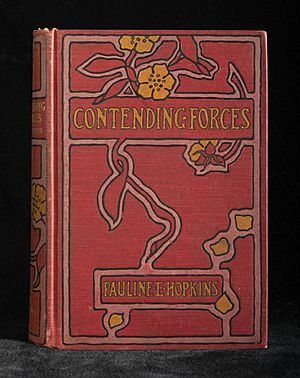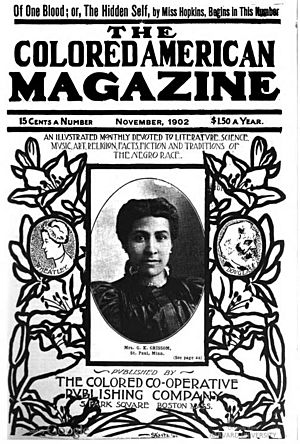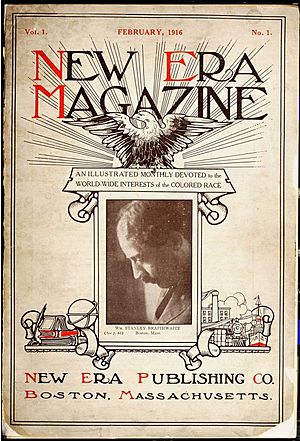Pauline Hopkins facts for kids
Quick facts for kids
Pauline Hopkins
|
|
|---|---|

Hopkins circa 1901
|
|
| Born | Pauline Elizabeth Hopkins 1859 Portland, Maine |
| Died | August 13, 1930 Cambridge, Massachusetts |
| Occupation | |
| Nationality | American |
| Genre | Romance novel |
| Notable works |
|
Pauline Elizabeth Hopkins (1859 – August 13, 1930) was an American novelist, journalist, playwright, historian, and editor. She was a very important writer who used romantic novels to talk about big social issues and race. Her first major novel, Contending Forces: A Romance Illustrative of Negro Life North and South, showed this new way of writing.
Hopkins also did amazing work as an editor for Colored American Magazine. This magazine was one of the first to celebrate African-American culture. It shared many short stories, essays, and novels. She was also connected to other important African-American leaders like Booker T. Washington and William Wells Brown.
Pauline Hopkins lived most of her life in Boston, Massachusetts. She wrote many of her famous works there. She was active in discussions about race, politics, and women's rights. Hopkins is known as one of the key thinkers of the early 1900s. She used her writing to help improve life for African Americans.
Contents
Early Life and Inspiration
Pauline Hopkins was born in Portland, Maine. She grew up in Boston, Massachusetts. Her parents were Northrop Hopkins and Sarah A. Hopkins. Her family encouraged her to study and love books.
From a young age, she was inspired by great African-American leaders. One of them was Frederick Douglass. She once said he had "god-like gifts" after hearing him speak. In 1874, when she was still in high school, she won an essay contest. The contest was funded by William Wells Brown, a former slave, novelist, and playwright. Her essay was called "Evils of Intemperance and Their Remedy." It talked about the problems of not being in control and how parents should guide their children. She won $10 in gold for her essay.
Hopkins also became known as an actress and singer. In 1877, she performed in her first play. She acted in several other plays and got good reviews. But in the early 1900s, she decided to focus more on writing.
Literary Works and Magazine Contributions
Plays, Novels, and Short Stories
Pauline Hopkins' first known play was a musical called Slaves’ Escape; or, The Underground Railroad. It was performed in Boston in 1880. She also wrote another play that was never published. It was based on the Bible story of Daniel in the lions' den.
In 1900, she published her short story "Talma Gordon." Many people say it was the first mystery story written by an African American. Her first novel, Contending Forces: A Romance Illustrative of Negro Life North and South, came out in 1900. In this book, she wrote about the challenges African Americans faced. This was during a time of racism after the Civil War.
Between 1901 and 1903, she published three more novels. These were released in parts (like a TV series) in Colored American Magazine. They were Hagar's Daughter: A Story of Southern Caste Prejudice, Winona: A Tale of Negro Life in the South and Southwest, and Of One Blood: Or, The Hidden Self.
Of One Blood: Or, The Hidden Self
Of One Blood: Or, The Hidden Self was Hopkins' last novel. It first appeared in The Colored American Magazine in late 1902 and early 1903. This was when Hopkins was the magazine's editor.
The story is about Reuel Briggs, a medical student. He doesn't care much about being Black or African history. But he goes on an archaeological trip to Ethiopia. He wants to find lost treasures, and he does. However, he discovers much more: a difficult truth about his family, race, and a part of his history he never knew. Hopkins wrote this novel to "raise the stigma of degradation from [the Black] race." The title, Of One Blood, means that all humans are connected.
Even though Of One Blood is a made-up story, Hopkins used historical facts and travel books to make a point. She argued that the ancient cultures of the Nile Valley came from Africa. This idea was different from what many historians believed at the time.
Work at Colored American Magazine
Pauline Hopkins was a very important part of Colored American Magazine's success. Her short story "The Mystery Within Us" was in the very first issue. The same company that published her novel Contending Forces started this monthly magazine.
By the second issue, she was named Editor of the Women's Department. By November 1903, she became the Literary Editor. She also wrote articles called "Famous Women of the Negro Race" and "Famous Men of the Negro Race." These articles honored many important Black figures of the time. They shared details about their lives and achievements. One person she wrote about was William Wells Brown. He was the same person who gave her an award for her essay when she was a teenager.
Sometimes, Hopkins used the name Sarah A. Allen for her work. Her work at the Colored American became well-known. She was even offered a spot on the board of directors. She also became a shareholder and a lender to the magazine. She helped the magazine get more subscribers and raise money. She was a co-founder of "The American Colored League" in 1904. This group worked to promote the interests of the Colored American magazine.
Her roles helped her become a major figure in the literary world. Her writing made up a large part of the magazine's content. She worked for the magazine until September 1904. She had to leave due to health problems. By the time she left, six of her short stories had been published there. This included the famous mystery "Talma Gordon." Also, two of her novels, Winona and Of One Blood, were published in the magazine.
New Era Magazine
Hopkins' last major works were for the New Era Magazine. She started this Boston-based magazine with Walter Wallace. He had also worked at the Colored American Magazine. The cover of New Era Magazine said it was "An Illustrated Monthly Devoted to the World-Wide Interests of the Colored Race."
The magazine wanted to be a place for African Americans to share their literary and political ideas. This was during a time when Black people were kept separate from others. But the magazine only published two issues in 1916. It then stopped being published and didn't get much attention. Many people see this as the quiet end of Hopkins' writing career.
Legacy and Impact
Pauline Hopkins is remembered for writing one of the first mystery plays by a Black woman. She is also known as "the most prolific contributor to the Colored American Magazine." She helped shape what the magazine became.
Her articles, like "Famous Women of the Negro Race," fought against unfair ideas about African Americans. They showed the great successes of Black people, especially women.
In 1988, Oxford University Press republished her novel Contending Forces. This was part of a special series called The Schomburg Library of Nineteenth-Century Black Women Writers. Her magazine novels were also reprinted in this series. This helped bring Hopkins' work back into the spotlight. It showed how her writing influenced past, present, and future writers.
Her work is seen as important alongside other famous African-American writers. These include Charles Chesnutt, Paul Laurence Dunbar, and Sutton Griggs. One expert called her "the single most productive black woman writer at the turn of the century."
Pauline Hopkins' family background, the Northups, was known for public action and strong community spirit. She carried on this legacy in her own life and writing.
Death
In her later years, Pauline Hopkins worked as a stenographer (someone who writes notes quickly) for the Massachusetts Institute of Technology. She passed away on August 13, 1930. She was injured in an accident where bandages on her arms caught fire from an oil stove. She died in Cambridge, Massachusetts.
Even though she lived and worked in the Boston area for most of her life, her death was not reported in local newspapers. However, two African-American newspapers, The Chicago Defender and the Baltimore-Afro-American, did report her death. They incorrectly said she was 79. Records show she was actually 71. Many details about her life, including her exact birthdate, are still being discovered today.
Published Works
- Slaves’ Escape; or, The Underground Railroad, 1880.
- "Talma Gordon". First published in The Colored American Magazine, 1900.
- Of One Blood: Or, The Hidden Self. First published serially in The Colored American Magazine, 1903.
- Of One Blood was rereleased by the MIT Press as part of the Radium Age Series in 2022. This edition featured an introduction by Minister Faust.
See also
- The Music Trades, "History," "Post-1996 findings on Freund" (relating to Colored American Magazine)




